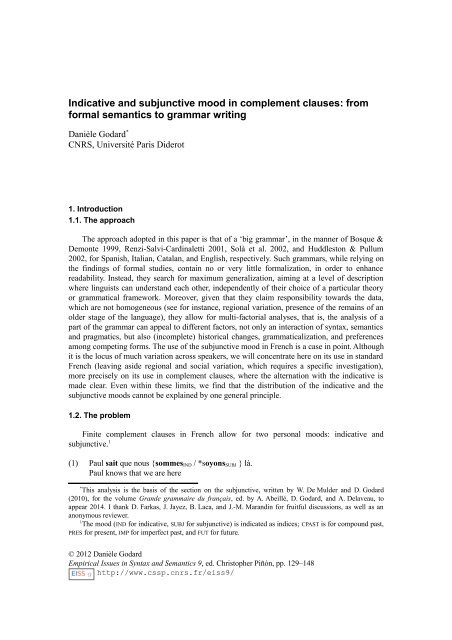Empirical Issues in Syntax and Semantics 9 (EISS 9 ... - CSSP - CNRS
Empirical Issues in Syntax and Semantics 9 (EISS 9 ... - CSSP - CNRS
Empirical Issues in Syntax and Semantics 9 (EISS 9 ... - CSSP - CNRS
Create successful ePaper yourself
Turn your PDF publications into a flip-book with our unique Google optimized e-Paper software.
Indicative <strong>and</strong> subjunctive mood <strong>in</strong> complement clauses: from<br />
formal semantics to grammar writ<strong>in</strong>g<br />
Danièle Godard *<br />
<strong>CNRS</strong>, Université Paris Diderot<br />
1. Introduction<br />
1.1. The approach<br />
The approach adopted <strong>in</strong> this paper is that of a ‘big grammar’, <strong>in</strong> the manner of Bosque &<br />
Demonte 1999, Renzi-Salvi-Card<strong>in</strong>aletti 2001, Solà et al. 2002, <strong>and</strong> Huddleston & Pullum<br />
2002, for Spanish, Italian, Catalan, <strong>and</strong> English, respectively. Such grammars, while rely<strong>in</strong>g on<br />
the f<strong>in</strong>d<strong>in</strong>gs of formal studies, conta<strong>in</strong> no or very little formalization, <strong>in</strong> order to enhance<br />
readability. Instead, they search for maximum generalization, aim<strong>in</strong>g at a level of description<br />
where l<strong>in</strong>guists can underst<strong>and</strong> each other, <strong>in</strong>dependently of their choice of a particular theory<br />
or grammatical framework. Moreover, given that they claim responsibility towards the data,<br />
which are not homogeneous (see for <strong>in</strong>stance, regional variation, presence of the rema<strong>in</strong>s of an<br />
older stage of the language), they allow for multi-factorial analyses, that is, the analysis of a<br />
part of the grammar can appeal to different factors, not only an <strong>in</strong>teraction of syntax, semantics<br />
<strong>and</strong> pragmatics, but also (<strong>in</strong>complete) historical changes, grammaticalization, <strong>and</strong> preferences<br />
among compet<strong>in</strong>g forms. The use of the subjunctive mood <strong>in</strong> French is a case <strong>in</strong> po<strong>in</strong>t. Although<br />
it is the locus of much variation across speakers, we will concentrate here on its use <strong>in</strong> st<strong>and</strong>ard<br />
French (leav<strong>in</strong>g aside regional <strong>and</strong> social variation, which requires a specific <strong>in</strong>vestigation),<br />
more precisely on its use <strong>in</strong> complement clauses, where the alternation with the <strong>in</strong>dicative is<br />
made clear. Even with<strong>in</strong> these limits, we f<strong>in</strong>d that the distribution of the <strong>in</strong>dicative <strong>and</strong> the<br />
subjunctive moods cannot be expla<strong>in</strong>ed by one general pr<strong>in</strong>ciple.<br />
1.2. The problem<br />
F<strong>in</strong>ite complement clauses <strong>in</strong> French allow for two personal moods: <strong>in</strong>dicative <strong>and</strong><br />
subjunctive. 1<br />
(1) Paul sait que nous {sommes IND / *soyons SUBJ } là.<br />
Paul knows that we are here<br />
*<br />
This analysis is the basis of the section on the subjunctive, written by W. De Mulder <strong>and</strong> D. Godard<br />
(2010), for the volume Gr<strong>and</strong>e grammaire du français, ed. by A. Abeillé, D. Godard, <strong>and</strong> A. Delaveau, to<br />
appear 2014. I thank D. Farkas, J. Jayez, B. Laca, <strong>and</strong> J.-M. Mar<strong>and</strong><strong>in</strong> for fruitful discussions, as well as an<br />
anonymous reviewer.<br />
1<br />
The mood (IND for <strong>in</strong>dicative, SUBJ for subjunctive) is <strong>in</strong>dicated as <strong>in</strong>dices; CPAST is for compound past,<br />
PRES for present, IMP for imperfect past, <strong>and</strong> FUT for future.<br />
© 2012 Danièle Godard<br />
<strong>Empirical</strong> <strong>Issues</strong> <strong>in</strong> <strong>Syntax</strong> <strong>and</strong> <strong>Semantics</strong> 9, ed. Christopher Piñón, pp. 129–148<br />
http://www.cssp.cnrs.fr/eiss9/











